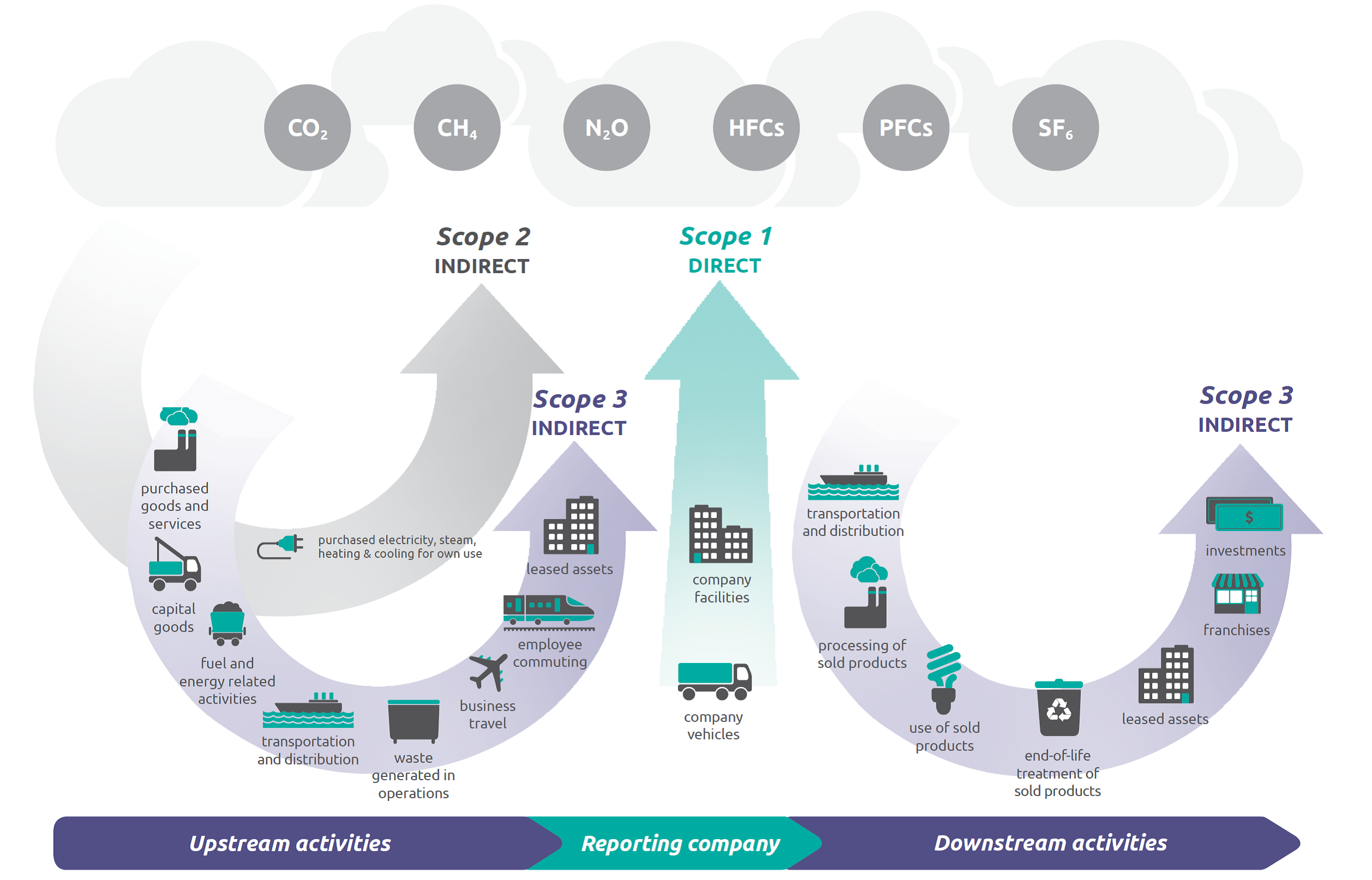Scope 1 and Scope 2 Inventory Guidance
Scope 1 emissions are direct greenhouse (GHG) emissions that occur from sources that are controlled or owned by an organization (e.g., emissions associated with fuel combustion in boilers, furnaces, vehicles). Scope 2 emissions are indirect GHG emissions associated with the purchase of electricity, steam, heat, or cooling. Although scope 2 emissions physically occur at the facility where they are generated, they are accounted for in an organization’s GHG inventory because they are a result of the organization’s energy use.
Overview of GHG Protocol scopes and emissions across the value chain

Establishing a relevant, complete, consistent, transparent, and accurate scope 1 and scope 2 emissions inventory is a process of continuous improvement. Table 1 provides a description of organizational phases of scope 1 and scope 2 engagement for common inventorying best practices. For some organizations, understanding GHG inventorying efforts within the broader market may spur competition and garner internal support for widening inventorying activities.
| Stage | Does your organization calculate and publicly disclose scope 1 and scope 2 emissions? | Does your company track and publicly disclose energy usage? | Does your company receive third-party verification for its scope 1 and 2 emissions and publicly disclose the results? |
|---|---|---|---|
| No activity | Organization does not calculate and publicly disclose any scope 1 or scope 2 emissions | Organization does not track and publicly disclose energy usage. | Organization does not receive third-party verification for its scope 1 and 2 emissions or publicly disclose the results. |
| Entry-level | Organization calculates and publicly discloses all major sources of scope 1 and scope 2 emissions. | Organization tracks and publicly discloses major sources of energy usage. | Organization receives third-party verification for a portion of its scope 1 and 2 emissions and publicly discloses the results Third party verification is done to a limited level of assurance. |
| Intermediate | Organization calculates and publicly discloses all scope 1 and scope 2 emissions. Organization has created year-to-year processes to continue disclosing scope 1 and scope 2 emissions. |
Organization tracks and publicly discloses all energy use and has created year-to-year processes to continue tracking energy usage. | Organization receives full third-party verification for all its scope 1 and 2 emissions and publicly discloses the results. Third party verification is done to a limited level of assurance. |
| Advanced | Organization has calculated and publicly disclosed all scope 1 and scope 2 emissions for at least 5 years and has created year-to-year processes to continue disclosing scope 1 and scope 2 emissions. | Organization has tracked and publicly disclosed all energy usage for at least 5 years and has created year-to-year processes to continue tracking energy usage. | Organization receives third-party verification for all its scope 1 and 2 emissions and publicly discloses results. Third-party verification is done to a reasonable level of assurance, preferably from an accredited verification body. |
Scope 1 and Scope 2 Resources
The following EPA guidance documents describe methods to calculate and report emissions from scope 1 and scope 2 sources.
- Direct Emissions from Stationary Combustion (pdf) is used to identify and estimate direct GHG emissions from stationary (non-transport) combustion of fossil fuels at a facility (e.g., boilers, turbines, process heat).
- Direct Emissions from Mobile Combustion Sources (pdf) is used to identify and estimate direct GHG emissions associated with fuel combustion in owned or operated mobile sources.
- Indirect Emissions from Purchased Electricity (pdf) is used to identify and estimate indirect GHG emissions resulting from the purchase of electricity, steam, heat, or cooling.
- Direct Fugitive Emissions from Refrigeration, Air Conditioning, Fire Suppression, and Industrial Gases (pdf) is used to identify and estimate direct emissions of GHGs from refrigeration and air conditioning systems, fire suppression systems, and the purchase and release of industrial gases.
The GHG Protocol published Scope 2 Guidance that standardizes how corporations measure emissions from purchased or acquired electricity, steam, heat, and cooling.
Note: Many industrial sectors also have process-related emissions sources that are specific to their sector. EPA’s Greenhouse Gas Reporting Program provides guidance and tools that can aid in the calculation and reporting of these emissions.
